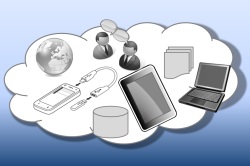 We have great gadgets with state of the art wireless connectivity technologies around us, in our pockets, on the office desk or on the bedroom drawer. Everything is network enabled these days, be it your TV, printer, eBook reader, USB drive, game console or almost any device with a screen and buttons. That’s the way it should be and that’s how it increasingly will be.
We have great gadgets with state of the art wireless connectivity technologies around us, in our pockets, on the office desk or on the bedroom drawer. Everything is network enabled these days, be it your TV, printer, eBook reader, USB drive, game console or almost any device with a screen and buttons. That’s the way it should be and that’s how it increasingly will be.
Why is it then that we’re still required to plug in a variety of USB cables into some of these devices? Not for charging it with electricity, but for loading it up with bits. If I’m able to consume much of the bits already through the wireless network connection that hooks me up with the great big data cloud of the Internet, then how can there be another category of bits that must still travel through the cable?
Let me illustrate the issue through two recent experiences I’ve had, one sponsored by Apple and the other by Nokia.
Case iPad 2 and iTunes
I recently decided it was finally time for me to give up on trying to steer clear from Apple products. The tablets are not just a new revision of the mini-PC/netbook boom from three years ago, I believe there’s much more to them. If the netbooks were about squeezing the familiar PC experience into a more portable form factor with a lower price tag, the tablets are aiming to bring us the smartphone experience of iOS and Android on a not-so-miniature device that gives better room for content presentation and user interface design. You could say it’s a case of less vs. more, which tends to trigger the primitive human reaction of “more is better”. I was so impressed with what my 4.3″ Android smartphone was capable of delivering compared to my previous 3.2″ gadget with the same OS + applications that I wanted to see what happens when you keep adding up more hardware goodness in a similar environment.
In an ideal world I would have preferred to purchase an Android tablet, as there are several reasons why I believe it will eventually become the leading platform for tablet computers and applications. However, the future is not here yet, as we’re pretty much lacking both the Android tablet computers and applications right now. Devices like the Samsung Galaxy Tab with pre-Honeycomb/3.0 version of the Android OS are not true tablets in my opinion. Also the current Android applications designed for a typical 3.5″ smartphone screen probably wouldn’t deliver the “more” effect I’m after. There’s no way around it, iPad rules for the time being. With the recent launch of v2 it was also easier to justify why now is a convenient time to invest in new hardware.
I won’t bore you with a general iPad 2 review here, I’ll just state that it totally rocks your socks off. Now, the one thing that doesn’t rock one single chord is the fact that you need to plug the device into a PC/Mac equipped with iTunes just to turn it on. In a way I understand the need for the iPad activation as a part of the bigger picture that includes the App Store, credit card billing, DRM and all that jazz. A necessary evil if you are stepping into the light /dark side (depending on one’s point of view) of the Apple empire. However, there’s some big irony in the whole post-PC era gospel preached by Steve Jobs when the product that should lead us into this era starts its life with a navel cord attached to a PC.
It’s no secret that I hate the iTunes application and what it has become. If I only had to use it as an occasional maintenance dock for the iPad OS updates and user identity verification, I might be able to live with this handicap. Unfortunately that’s not quite the end of the story. 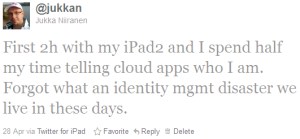 After having hooked up my iPad into all the usual web services like Facebook, Twitter, Gmail, Google Reader etc. (which inspired this tweet), I wanted to see how this thing works on consuming some less dynamics content, meaning books. I have a Kindle 3 and love the experience when used in conjuction with Amazon’s book store account, but not all of my eBooks are Kindle optimized. Some things just work better in PDF and especially in color, so the beautiful iPad screen should really shine with this type of content.
After having hooked up my iPad into all the usual web services like Facebook, Twitter, Gmail, Google Reader etc. (which inspired this tweet), I wanted to see how this thing works on consuming some less dynamics content, meaning books. I have a Kindle 3 and love the experience when used in conjuction with Amazon’s book store account, but not all of my eBooks are Kindle optimized. Some things just work better in PDF and especially in color, so the beautiful iPad screen should really shine with this type of content.
What I would like to see for the iPad is a similar service as Amazon has, where you can email PDF’s to Amazon and they’ll optimize it for you and deliver the book into your Kindle, wirelessly through a WiFi connection. Ok, email may not be an elegant choice of technology, but the process flows very smoothly for the user.  When I wanted to achieve the same end result for the iPad, I was initially completely lost on what I should do. I had downloaded the iBooks application from the App Store and it did have a Store button allowing for book purchases (but of course not for us Finns, as there’s nothing on sale in the local iTunes book store, except freely available books). How was I supposed to get my own content into the library?
When I wanted to achieve the same end result for the iPad, I was initially completely lost on what I should do. I had downloaded the iBooks application from the App Store and it did have a Store button allowing for book purchases (but of course not for us Finns, as there’s nothing on sale in the local iTunes book store, except freely available books). How was I supposed to get my own content into the library?
I hooked up the iPad into its navel cord again and launched iTunes. Since you can’t just copy files on an iPad, like you would for any other USB-enabled device with internal memory, there had to be a way here to get the PDFs flowing into the iPad. I didn’t see any menu item related to books or PDFs, the only synchronizable content appeared to be the usual iTunes bits for music, video etc. Finally after rubbing my head for a while and clicking around the menus, I figured it out: I had to perform the “add files to a library” process on my PC’s iTunes instance. Selecting PDF’s brough up a new category called “books” in the library, which also then became available as a syncrhonizable category for the iPad when the device is plugged in with the cable. A few more clicks, then performing a synchronization operation for the very first time (since my music and photos are already online in Spotify or Picasa Web Albums) and eventually the content appeared inside the iBooks app.
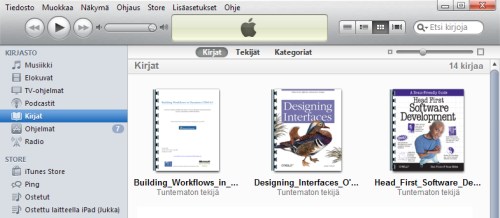
Does this process make sense on a device that has both WiFi and 3G always-on internet connection (which often doesn’t work, by the way)? Like hell it does. The tablet computers are essentially big windows into the cloud of content that the web has to offer for us. They are not media players like the early iPods, where you transfer bits from your home media banks into a mobile device. That was the world ten years ago, why must the shadow of iPod and iTunes still haunt the iPad? At a bare minimum, the content synchronization should be something you can perform wirelessly instead through the USB port, but ultimately iTunes as we know it has to be removed from the process completely.
When we look at the competition ahead, Google doesn’t have any legacy comparable to iTunes, which is why the Android devices are much better prepared for the post-PC era with no strings (cables) attached. For the average tech consumer it may not feel like such a huge drag, and I’m sure Mac/iPod users don’t pay much attention to it at all. Nevertheless, the behaviour patterns everyone is learning from more recent services like Dropbox or Spotify will make Apple’s inconvenient truth gradually ever more visible to their customers.
Case Nokia C7, Symbian^3 and Ovi Suite
Speaking of Dropbox, after initial scepticism of the service’s alleged greatness, I’ve grown to love its beauty of simplicity and ubiquity. The service runs on my home PC, work PC, Android phone and iOS tablet, quietly taking care of small but important tasks such as making sure my KeePass database of usernames and passwords is always available wherever I go. The ability of Dropbox to deliver a dead simple way for masking the file transfer and synchronization complexity into a simple folder that’s available across devices makes it the perfect service for “normal” people who are not interested in the geeky side of technology and gadgets. It just works.
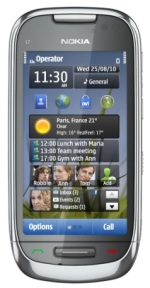 My dad recently bought a new mobile phone, a Nokia C7. I didn’t have the heart to try and convert him into an Android user, as the leap from traditional “dumbphones” built for phone calls, into a full-blown portable computer like the modern smartphones, might have been too long. If SMS is only just becoming a routine for you, it’s maybe best that your first smartphone resembles a mobile phone that’s familiar to you. That’s pretty much what Nokia offers. The C7 has a decent touch screen and a Symbian^3 OS with a few bits and pieces of what iOS, Android and WP7 (why not start including it in the list now) are made of, but at the end of the day an average user might easily mistake it for an S40 mobile. Sometimes this is not such a bad thing at all, we must keep this in mind.
My dad recently bought a new mobile phone, a Nokia C7. I didn’t have the heart to try and convert him into an Android user, as the leap from traditional “dumbphones” built for phone calls, into a full-blown portable computer like the modern smartphones, might have been too long. If SMS is only just becoming a routine for you, it’s maybe best that your first smartphone resembles a mobile phone that’s familiar to you. That’s pretty much what Nokia offers. The C7 has a decent touch screen and a Symbian^3 OS with a few bits and pieces of what iOS, Android and WP7 (why not start including it in the list now) are made of, but at the end of the day an average user might easily mistake it for an S40 mobile. Sometimes this is not such a bad thing at all, we must keep this in mind.
The big screen and the capable camera make the C7 a nice gadget for shooting photos. Nokia has always been great at hardware and if I’d have to find a way to regularly get high quality photos captured with an Internet enabled device, I’d probably turn to Nokia’s product catalog, just due to their reputation on camera performance compared to the many lame efforts of Asian smartphone manufacturers. Based on this reputation, I had assumed that the process of taking photos and performing actions on them in Symbian^3 would at least be on par with Android. Surely many members of the product marketing team must have been faced with the situation of having to demonstrate the camera functionality of Nokia products, just to draw the attention away from anything related to browsing web content or other weak spots of Symbian. Well, from my experience with C7, I now think they’ve never bothered to proceed beyond snapping a photo with the device. You know, like, sharing it with some other device or application.
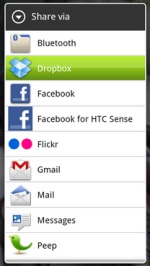 On an Android device, I can click on any picture to bring up the Share menu, which presents all the applications installed on the device that have the ability to integrate with the camera/gallery. Dropbox is my favorite method for moving pictures into an archive, but Facebook sharing and all other social applications are also very potential candidates for the next action I have in mind after taking a photo. If I install new apps, the menu gets appended with them. No need to spend any time wondering what to do, it all just works right in the context.
On an Android device, I can click on any picture to bring up the Share menu, which presents all the applications installed on the device that have the ability to integrate with the camera/gallery. Dropbox is my favorite method for moving pictures into an archive, but Facebook sharing and all other social applications are also very potential candidates for the next action I have in mind after taking a photo. If I install new apps, the menu gets appended with them. No need to spend any time wondering what to do, it all just works right in the context.
What are the options on a C7? Well, you can of course 1) send an MMS (do people still use those?), 2) attach it to an email or 3) send it via Bluetooth. All of these options probably would have felt useful five years ago, but as of today they all just scream legacy to me. Ok, perhaps the problem is just that the stock C7 doesn’t come with all the necessary apps, so lets go and login to Ovi Store. I’d imagine a search term like “photo sharing” would shed some light on the best way to proceed. No, nothing useful here. Since none of the top mobile app brands from the world of iOS and Android are available on the Symbian platform, even a geek like me finds himself having another one of those “iTunes moments” where the familiar logic of solving a problem doesn’t seem to work.
Sugarsync is the closest thing to Dropbox on Symbian, so let’s install that one. I get the PC application installed, even though the folder configuration is not nearly as intuitive as Dropbox. I manage to download the mobile app from Ovi Store and seemingly also connect the C7 to the same user account as the PC. The folder structure looks different from this angle, there’s some bizarre “briefcase” concept blocking my view etc. but it looks like this could in theory work for photo sharing. Except that when I start the process from capturing a new photo and wanting to move it to Sugarsync’s folder, I cannot figure out any sensible way to complete this task. The share menu is of course not updated as it would be on an Android. There is no easy navigation path between the photo gallery, the file system and the sharing application. Unless you want to work with memorizing and moving cryptic Pic123456.jpg files inside file explorer, there’s no solution. It just doesn’t work.
I refuse to give up and try another cloud based content syncrhonization application (forgot the name already). Usability is even worse on this one and I’m actually not even able to complete the pairing process of the PC and the phone, because I started by creating the user accoung in a different device than what the online registration wizard assumes. Well, I’m 100% sure that this is not a big loss. At the end of the day, I register a Gmail account for my father and just instruct him to email the photos from his brand new smartphone as attachments to his own address. I feel completely defeated for having to suggest such a lame process. My foolish cloud dreams have been shattered once again.
Of course there is a way to perform content transfer between the Nokia C7 and a PC. The answer is Ovi Suite. You need to install this Nokia’s equivalent of iTunes onto your computer, then plug in your shiny new mobile device with a USB navel ch… cable into your computer and perform a synchronization of the gallery items. To add insult to injury, the micro-USB cable supplied with C7 is about 10cm long. Sure, you could start playing with Bluetooth device paring and all that, but that’s another experience I want to spare my old man from. Also, unlike with Apple hardware, you’re actually allowed to mount the phone directly as a USB drive (well, I assume you are, didn’t try it with C7), but that is all still cable games.
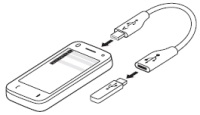 Nokia even offers an advanced USB On-the-go feature, which lets you connect other devices or mass media directly on the Nokia phone which acts as the master device. Great, but what’s really your fetish with those cables? You’ve already given up on producing rubber boots, isn’t it time to give up the rubber cables next?
Nokia even offers an advanced USB On-the-go feature, which lets you connect other devices or mass media directly on the Nokia phone which acts as the master device. Great, but what’s really your fetish with those cables? You’ve already given up on producing rubber boots, isn’t it time to give up the rubber cables next?
“Quit whining and plug it in!”
You may consider me a spoilt geek who has nothing better to do with his time and gadgets than to complain about what features they are lacking. Fine, maybe that’s also true, but here’s the underlying motivation why I write posts like this: when I observe how the world is changing slowly but surely towards a particular direction, it allows me to also spot those little pieces of the world that are standing still, i.e. getting left behind. Those little things represent potential disruptions to traditional businesses and business models, which to me are a very intriquing topic. As they say, shift happens.
Here’s how the world looks from my eyes today:
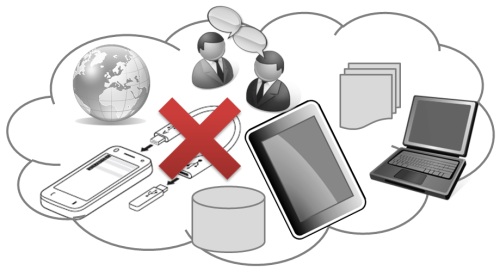
See? It’s all in the cloud already – today. The devices are connected to the cloud, the content is mostly in the cloud, also the people have arrived in there thanks to the social media breakthrough. What’s the one thing that doesn’t belong there? Yep, correctomundo, you guessed it right.
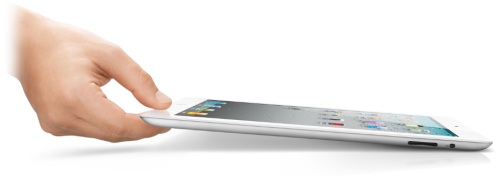




One Response
Stay in touch with the conversation, subscribe to the RSS feed for comments on this post.
Continuing the Discussion